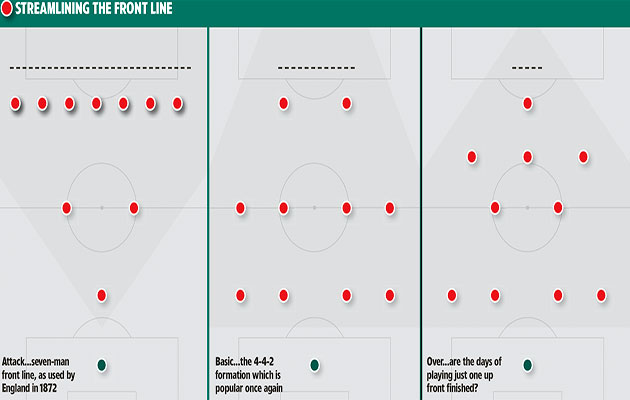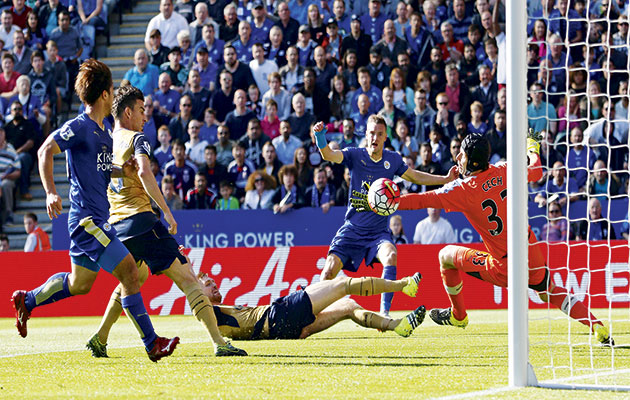This season’s Premier League is one that would not feel out of place 30 years ago. The familiar stratification has broken down, even the best sides are inconsistent and it feels as though every round of games brings at least one major surprise.
Perhaps it’s simply a freak, a rare coincidence of middling teams finding form and confidence just as the elite go through debilitating transitions.
Perhaps it is the shape of things to come, the saturation of television money meaning almost everybody is buoyant.
But there has also been an intriguing tactical shift, one that enhances the sense of this being a retro-season. There has been a return – at Leicester City and Watford most notably – of systems with twin strikers, something that runs contrary to the general trend first outlined by the great Dynamo Kiev coach Victor Maslov in the late 1960s. “Football,” he explained, “is like an aeroplane. As velocities increase, so does air resistance, and so you have to make the head more streamlined.”
That implies a linear evolution and, in the most general sense, that is how tactics have developed. When England played Scotland in the first international in 1872, they fielded seven forwards. Almost a century and a half later, in an age of false nines, it’s not uncommon for teams to play without any out-and-out forwards at all.

It would appear that the process of streamlining has reached its end point. With football seemingly unable to go any further down this road, it is now heading in the one direction it can: backwards.
While not untrue, it is a simplified representation, leading from the invention of passing at Queen’s Park through RS McColl to Newcastle United, through Peter McWilliam to Tottenham Hotspur, through Vic Buckingham to Ajax, through Rinus Michels and Johan Cruyff to Barcelona and Pep Guardiola is a beguiling one. But that is one part of the picture; the landscape is far more complicated than that.
Various claims have been made that Total Football was invented, not in Amsterdam in the 1960s but in Hungary in the 1950s or Sunderland in the 1930s or Leicester in the 1960s. On the one hand such claims are nonsensical, based on partisanship and a failure to recognise that possession-based inter-movement is only part of what made Total Football so effective.
The co-ordinated pressing that made Ajax so devastating arguably wasn’t even physically possible until the nutritional developments of the late 1960s. Tactically it’s difficult to see how it could have functioned without the platform of a back four, which only became widely accepted in the early 1960s.
Great developments, however, very rarely spring fully formed from the mind of their creator.
Passing and moving was the first great tactical development, introduced by Scotland in that inaugural international, and was tried in increasingly adventurous deployments thereafter. Some worked and some did not, but it came to the fore when combined with the sort of ferocious pressing pioneered by Maslov at Dynamo and Michels at Ajax.
Tactical history is not simply the story of great men having great ideas in sequence; it is far more complex than that.
Much of the development is reactive. One team does a thing and their opponent tries to work out a way of countering it. For a time, five years or so ago, Barcelona-style possession football held sway. Then
it was realised that it could be neutered by sitting deep and absorbing pressure, with the ball becoming less important.
“Gegenpressing” and rapid transitions have become the fashionable way to play.
Why have twin strikers come back? Well, perhaps because a lot of defences had grown used to playing against a single striker. One centre-back marks and the other covers. The art of defending one-on-one was lost.
It’s widely accepted there is a dearth of great centre-backs in the world at the moment and that may be a contributory factor. Play two strikers and make the two centre-backs defend.
If your style is to get the ball forward quickly, when is it easier to do that? With one striker to hit or two? Fielding two strikers still leaves the classic two banksof four to frustrate the opposition.
A 4-4-2 set-up is a simple, pragmatic way to play, and as expertise in dealing with it has waned so it has become more effective again.
By Jonathan Wilson







